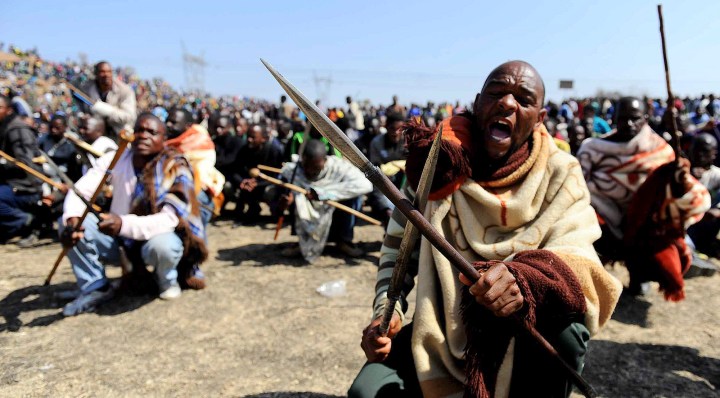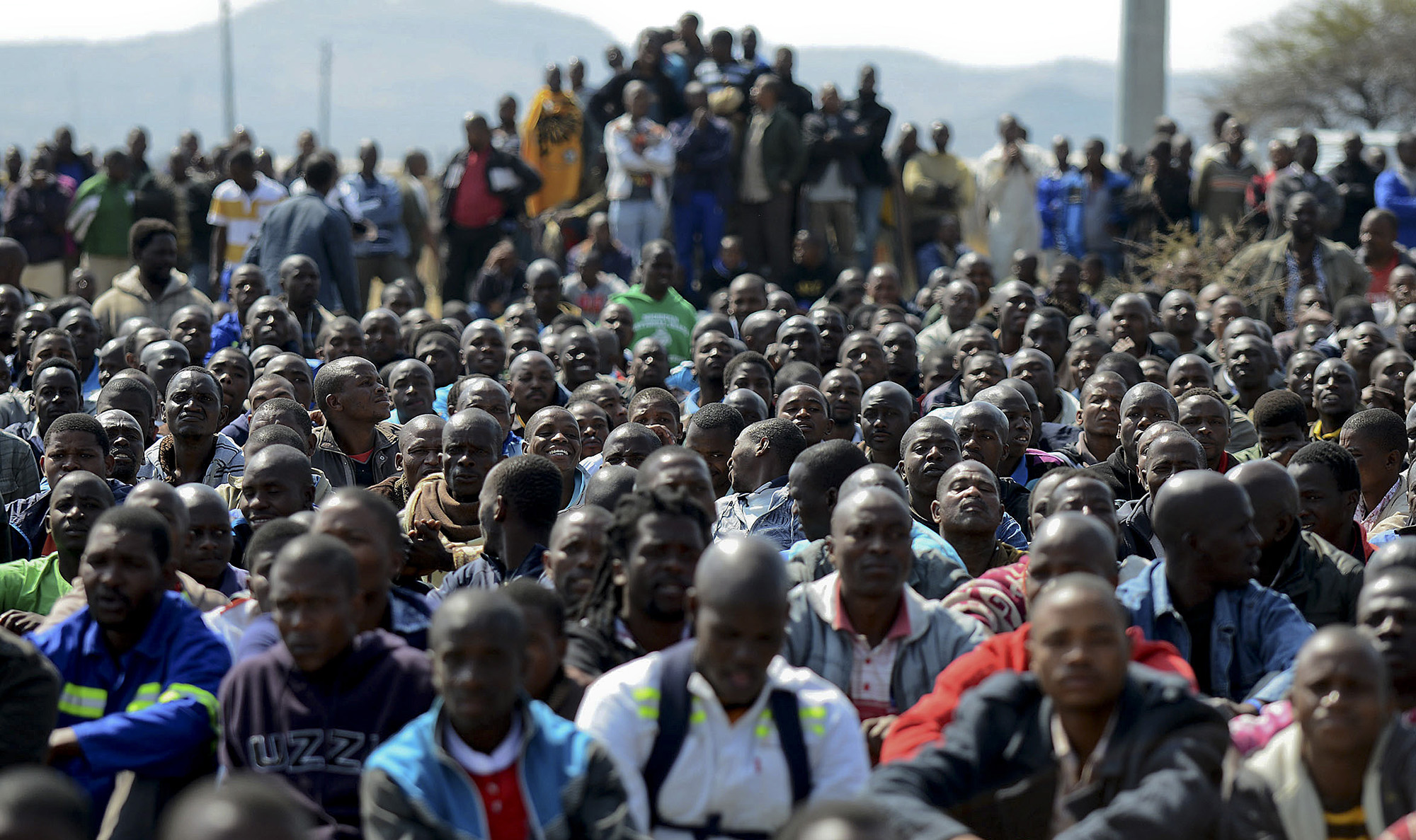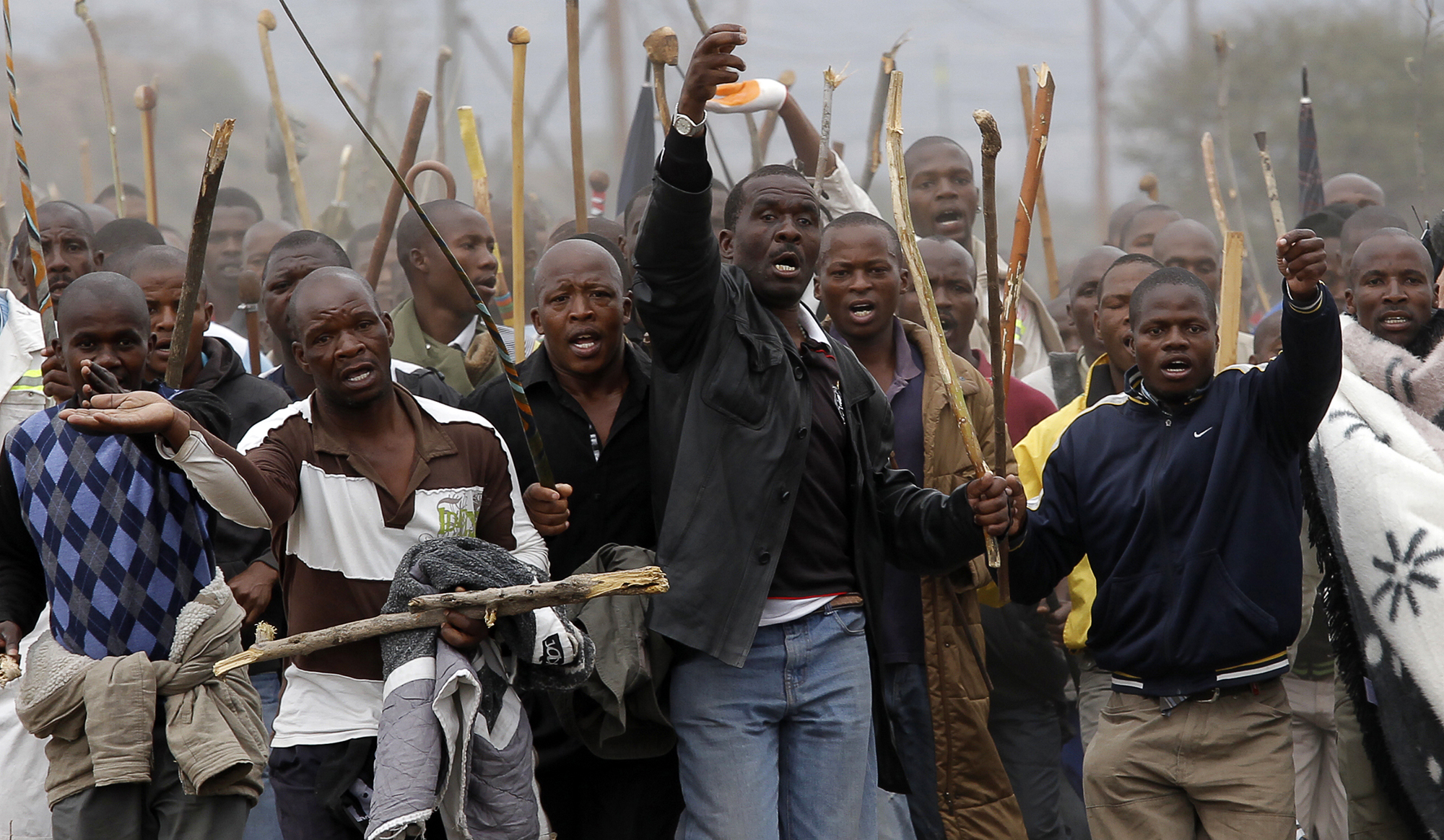MASSACRE REMEMBERED
Ten years on, the Marikana truth-tellers still carry the weight of what they uncovered

In the direct aftermath of the Marikana massacre, the narrative put out by police was that mine workers were shot by cops in danger acting out of self-defence. This might have stayed the official story of Marikana — were it not for a brave team of researchers led by Kate Alexander and battle-hardened journalist Greg Marinovich.
What happened at the mining town of Marikana on 16 August 2012 wasn’t always known as a “massacre”.
The events on the day that left 34 Lonmin mine workers dead were initially termed a “tragedy”. Striking miners, emboldened by muti, had attacked police who were doing their best to control a tense stand-off. Frightened cops acting in self-defence had fired back. Lives had tragically been lost.
This was the story disseminated by police and publicised by the media. With over 250 miners held in police custody in the days after, there were no eyewitnesses free to tell a different tale: one of how miners were hunted down like animals on a secret killing field.
And that’s the way it might have stayed.
The researchers who tried to tell the world
It was only when Professor Kate Alexander and her researchers visited Marikana for themselves, in the days directly after 16 August, that they began to apprehend the true horror of what had happened.
“Only then did we begin to realise that the police had murdered workers, and that this was not a two-sided affair as was being presented in the media,” Alexander told Daily Maverick.
Alexander was at that point the SA Chair in Social Change at the University of Johannesburg and had almost immediately become discomfited by the way in which the violence was being framed publically.
Visit our Marikana anniversary page for more analysis and reflections.
“The discourse was about the financial impact on South Africa, and then the political impact. None of this was dealing with what actually happened,” Alexander says now.
At Marikana with her team of researchers, quizzing workers as to what might have really happened, the academic realised that the Wonderkop hill behind the Lonmin mine, which was assumed to have been the primary site of the violence, only told a fraction of the real story.
There was a second crime scene, several hundred metres from Wonderkop, which Alexander and her team termed the Killing Koppie.
“I still can’t get it out of my mind,” Alexander says.
“There were signs of blood all over the place. There was a green colour, which we understood to be the colour of the dye in the [police] water cannons. There was also lots of clothing — a lot of it seemed to be the bottom of people’s trousers, cut off by medics. But dried blood, congealed blood, everywhere.”

Striking Lonmin mine workers listen to former ANC Youth League President Julius Malema at Wonderkop informal settlement in Marikana near Rustenburg, South Africa, 18 August 2012. (Photo: EPA / STR)
What the researchers also found: yellow letters painted seemingly randomly on rocks and boulders around the koppie. They took a guess, which would turn out to be correct: that the letters marked spots where the bodies of dead miners had lain.
Alexander and her researchers took photographs and made notes in what was still a highly fraught environment. Concerned that armed police might try to prevent them leaving with their evidence, the team hid memory cards around the car. Upon returning to Johannesburg, Alexander wrote up their findings as quickly as possible and published them that night on a British website with which she had a long relationship, the Socialist Worker.
But the publication of the first account getting close to what really happened at Marikana prompted almost nothing in response.
“There was silence,” Alexander says.
People seemed to find the claims made too outlandish to be plausible, and the fact that they were carried on a website that few South Africans were familiar with didn’t help. As first one week passed, and then another, there was little indication that local journalists would follow up on Alexander’s team’s incendiary findings.
Alexander was deeply worried. What if rain washed away all traces of the bloodbath at the Killing Koppie, and the police’s self-exonerating version of events became the official historical record?
But there was one journalist who did take Alexander’s claims seriously, and who was hard at work on a piece of reporting that would comprehensively shift the Marikana narrative.
Enter Greg Marinovich
Greg Marinovich, a Pulitzer Prize-winning local photojournalist who shot to international fame as a result of his work covering the death rattles of apartheid with the so-called Bang Bang Club, had been growing ever more intrigued by what he was hearing about a Lonmin strike near Rustenburg in mid-August 2012.
“I was hearing on the radio that miners [leading the strike] were not allowing journalists access to the workers,” Marinovich told Daily Maverick.
“There was all this talk of witch doctors and muti and men in blankets. I wanted to go look; I was getting curious. I thought, maybe the journalists are young, maybe they don’t know how to deal with this particular vibe. I thought, Ag, let me go.”
Marinovich drove to Marikana on what would turn out to be the day before the massacre. The photojournalist was no stranger either to protests or to situations of industrial unrest, but he says today that there were already features of the Lonmin strike that seemed unusual.
Visit Daily Maverick’s home page for more news, analysis and investigations
“Both sides were clearly very hardened,” he says.
By 15 August 2012, at least two cops and four miners had already been killed in skirmishes resulting from workers trying to cross the veld beneath Wonderkop.
“The cops were in shock and angry and nervous. The miners were hardcore. They had decided ‘everyone’s against us’, but they knew they couldn’t survive on [the salaries] they were making.”
Marinovich stayed for hours talking to miners and taking photographs, but left once darkness fell.
As he drove back to Johannesburg that night, however, there was something gnawing at him.
“I had seen so many cops coming in. Columns of cops. Swat teams, anti-terrorist units…I thought: Uh-oh. This is not public order policing,” Marinovich remembers.
The murder fields of Marikana. The cold murder fields of Marikana.
From what he saw of the kind of weaponry being brought in, he was left in little doubt: “They’re not there for any kind of peaceful outcome”.
The next day, TV footage of police firing on miners would stun the world. Marinovich was on the scene by 4am the day after, where he recalls finding “so many cartridges and shells, it was like a proper battlefield”.
That was only from the main scene. The Killing Koppie remained hidden.
After talking to Kate Alexander in the days to come, Marinovich became convinced of the validity of the University of Johannesburg researchers’ findings. Still, he needed to confirm them for himself. The photojournalist returned to Marikana with UJ researcher Thapelo Lekgowa, who Marinovich says deserves the lion’s share of the credit for unearthing the Killing Koppie.
At that second site, Marinovich saw for himself what Alexander’s team had described: the yellow letters daubed on boulders around the koppie. He soon realised that the letters marked not just where bodies had lain, but also key pieces of evidence: an unfired pistol belonging to a mine worker, for instance.
“Once we had this information, trying to understand it was very difficult. There’s no systemisation [in South Africa] of how crime scenes are marked,” Marinovich says.
Police watchdog Ipid was investigating, but they wouldn’t tell Marinovich anything. Others connected to the scene, like lawyers representing miners’ families, were also staying tight-lipped. But the photojournalist’s vital break came when he learnt that well-known forensic pathologist Reggie Perumal had been hired on behalf of the victims.
Marinovich gave Perumal a call and asked what he had seen at the autopsies. The pathologist said he couldn’t reveal much — but he gave Marinovich more than enough, including conveying his horror at how many dead miners appeared to have been shot in the back.

Some of the thousands of striking mine workers from the Lonmin platinum mine march to the gates of the Karee Mine as part of their mass action in an attempt to get high wages, Marikana, South Africa, 5 September 2012. (Photo: EPA / Kim Ludbrook)
This clearly indicated that they had been killed while fleeing from police, rather than in the act of attacking them.
Marinovich initially wanted to wait to publish his story until he received some official confirmation from police matching what he now knew to be true. It rapidly became clear, however, that this confirmation might never come. He took the story to Daily Maverick, where editor Branko Brkic published it under the headline “The murder fields of Marikana. The cold murder fields of Marikana” on 8 September 2012.
“I knew I was right, and Branko backed me,” Marinovich says today.
“I’ve been in many situations where I’ve seen massacres, I’ve photographed massacres, I know what a massacre fucking site looks like. There was no other explanation for this.”
Threats follow — but little accountability
Both Alexander and Marinovich would become the target of criminal incidents and intimidation efforts in the weeks and months after publishing their findings.
Alexander reels off a list: “Our office was broken into. The electric fence around my house was cut, and laptops were stolen. My car was broken into in a sophisticated way. Someone stole the data on our Dropbox.”
As a way of taking out insurance, the academic went public with what was happening in the Mail & Guardian. She was later reliably informed that the actions probably stemmed from the State Security Agency.
Marinovich says the stress of living under threat took a particular toll on his family. The killing of miners did not stop at Marikana, he points out; he reported on the continued assassination of miners, which would include personal friends.
The photojournalist won a prestigious fellowship to Harvard in 2013, and moved his family to the US — where he still lives — accordingly. Today, he acknowledges that this move was not unrelated to Marikana and its aftermath.
The most bitter pill to swallow about the massacre for Marinovich has been the glaring lack of accountability for the politicians, police commissioners, and individual cops responsible.
Marikana’s Small Koppie: 14 dead, 300 metres away from Wonderkop. Why?
When it comes to Lonmin’s erstwhile major shareholder Cyril Ramaphosa, Marinovich shakes his head incredulously: “How did he walk away from that to become president? It’s insane!”
Alexander feels similarly. The professor points out that although the Farlam Commission which investigated the Marikana Massacre concluded that Ramaphosa was not responsible for murder, it did not consider another possibility.
“That is that Ramaphosa acted corruptly,” Alexander says.
She points out that Ramaphosa used his contacts in the ANC to lean on authorities to resolve the Lonmin strike as quickly as possible in order to benefit himself as the mining house’s major shareholder.
“That’s a form of corruption,” Alexander suggests.
For Alexander, the clearest message sent by the Marikana Massacre was one which was as evident in 1922, at the time of the Rand Rebellion, as it was in 2012 — and as it remains today.
“When the chips are down, the state will kill workers,” she says.
Marinovich has covered countless bloody conflicts in his photojournalism career, but he says the Marikana Massacre has stuck with him in a way he finds particularly hard to shake off.
“I’m a journalist, but first of all I’m a social activist,” Marinovich says.
“I did my journalism [during apartheid] because of my politics: to document it, to show what these bastards were doing. Then to have this democratic government commit a massacre and then cover it up? That hurt. That hurt.”
Marinovich pauses.
“It still hurts.” DM

















 Become an Insider
Become an Insider
Sorry, but the picture of theses noble strikers is quite revealing. Armed and threatening violence. Ten folks killed in the run up to the confrontation? Small wonder the police were having itchy fingers. South Africans must change from making every strike about violence to get noticed. Dealing with this incident without looking at SA’s industrial relations as a whole will be useless.
I was going to say, a stick is one thing, what is clearly a spear is another.
It also seems odd that these ‘commemorative’ articles by and large make no reference at all to the detailed findings of the Marikana Commission of Enquiry chaired by Judge Farlam (which took almost three years to complete).
Absolutely and it will go on hurting for as long as those with political power are never brought to account. Cyril has been a disaster. Time for a game change. Well done, DM. Watch your backs.
As the one with feet in both camps – Lonmin and Government – Ramaphosa is the most culpable for an atrocity reminiscent of Sharpeville.
Police critics need to join the SAPS, volunteer for the riot squad, and volunteer to be at the front line when there are violent protests/riots, and the protesters have already hacked to death several security personnel and police officers, and have refused a police instruction to disarm. They can then show the world how police SHOULD behave under those circumstances. If they’re not prepared to do that, their armchair opinions are irrelevant.
As far as the killing koppie is concerned, EVERY animal in the world, when it has been in a life threatening battle with an adversary that it has beaten, and is retreating, will chase it and inflict as much damage as possible. Only highly trained humans will resist the temptation, and they won’t be found in today’s SAPS.
Just to add. (1) Finding Scene 2 would have been impossible without my fellow fieldworkers Botsang Mmope and Thapelo Lekgowa. (2) It was not just me who experienced harassment from the state, it was also my colleague Prof. Carin Runciman